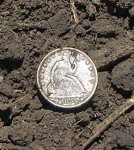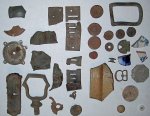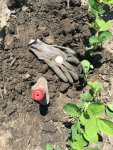C&RHunter
Active member
During my shelter at home time, I did some research for old home/cabin sites. I used Historic Mapworks and brought up the 1877 County Atlas for the area that I have hunted arrowheads for more years than I will say. Since I am familiar with the small river bottom fields there, using the atlas and google earth I can get a good idea of where the locations of the old structures should be. I saw that in the 1800s the old road used to go south along the east side of the field, but was relocated about a half mile to the west in the 1930s-40s. I imagine that is when the structure was removed and any foundation stones removed. The atlas showed a home about a quarter mile down the east side of the field, so Monday I went out to the bean field. The beans are about 5”-6” tall so I still have some time to hunt. (I have had permission for many years to be on the property) Locating the site was easy, as there were pieces of cork top bottles, dishes, crocks, etc scattered in an area about 250’ in diameter. Monday, during my 3 hour hunt, I found lots of bits and pieces of nonferrous and ferrous items. I did find three Fitz overall buttons that date from the 1930s and an aluminum Palmolive-Peet Company token for a free cake of Crystal White Laundry Soap from the 1920s. Nothing to get excited about for sure.
It was supposed to rain Monday night and Tuesday, but that never happened. About mid-day, I had this relenting feeling that I needed to go back and give it another shot, so away I went. I had only been there 10-15 minutes, and was still going down the first row of beans, when I got a signal that sounded good, kind of, if you know what I mean. I criss-crossed the signal, to find the center, and then cut a about a six inch plug. I scanned it but the target was still in the hole, so I used the pinpointer and the target was in the side of the hole. I cut that out, and I couldn’t believe what it was. A totally unexpected find, an 1854 O Seated Half. I saw the eagle on the back first, and thought it might be a Spanish coin. But when I turned it over I saw the seated Lady! The half was about 4”-5” down and must have been tipped in the ground is why the signal was okayish. The coin is holed and nicked on the edge, but as far as wear very little if any. Not bad for large silver coin that has been in a farm field that has been plowed, disked, plated, and chiseled for 160 years or so. (I may have scuffed it but don’t think so.) I recovered other typical items from the 1800s over the next 2-1/2 hours, before I gave it up for the day. I will return!
I was using the Nox 800, Field 2, 5 tones, 15 khz, recovery speed 5, and iron bias 4.
It was supposed to rain Monday night and Tuesday, but that never happened. About mid-day, I had this relenting feeling that I needed to go back and give it another shot, so away I went. I had only been there 10-15 minutes, and was still going down the first row of beans, when I got a signal that sounded good, kind of, if you know what I mean. I criss-crossed the signal, to find the center, and then cut a about a six inch plug. I scanned it but the target was still in the hole, so I used the pinpointer and the target was in the side of the hole. I cut that out, and I couldn’t believe what it was. A totally unexpected find, an 1854 O Seated Half. I saw the eagle on the back first, and thought it might be a Spanish coin. But when I turned it over I saw the seated Lady! The half was about 4”-5” down and must have been tipped in the ground is why the signal was okayish. The coin is holed and nicked on the edge, but as far as wear very little if any. Not bad for large silver coin that has been in a farm field that has been plowed, disked, plated, and chiseled for 160 years or so. (I may have scuffed it but don’t think so.) I recovered other typical items from the 1800s over the next 2-1/2 hours, before I gave it up for the day. I will return!
I was using the Nox 800, Field 2, 5 tones, 15 khz, recovery speed 5, and iron bias 4.







